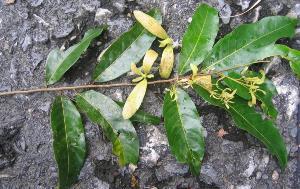Tue Ha Van
The project will be designed to conserve permanently three globally threatened tree species of Dipterocarpaceae family and their natural habitats through the provision of information conservation status and recommendations for sustainable use in Xuan Son National Park.

The flower and fruit of D. retusus.
Xuan Son National Park, one young Park belongs to Phu Tho province and the preserved priority area in Viet Nam, established in 1986. There is one typically mixed ecosystem between limestone and land-mountain so that it has high biological diversity, particularly the flora. The flora is diverse, included: 180 families, 680 genera and 1,217 species. There are 40 endangered species belong to 29 families of high vascular plant (following the report of IEBR, 2007). Dipterocarpaceae family has the most globally rare and threatened tree species and recorded four tree species, including both Dipterocarpus retusus Blume and Parashorea chinensis Hwang as vulnerable species (VU), Vatica subglabra Merr. as endangered species (EN) (category EN, VU of the IUCN classification) and Vatica diospyroides Sym..

Flower of Vatica subglabra.
Among them, two species as Parashorea chinensis and Dipterocarpus retusus which are only distributed in the Northern Viet Nam, especially they have survived in several national parks such as Cuc Phuong National Park, Xuan Son National Park and Huu Lien National Park and only there can we see mature individuals and natural regeneration of each species whereas rarely may the other places find. Because these tree species are commercial value, they are heavyly exploited in not-protected forest areas. The other reason, diversity of Dipterocarpaceae family in XNP is the highest of those of the other parks within the North of Viet Nam. In addition, a number of local people, consisting of Dao, Muong ethnic population, have lived for many years in core site of the park and whose living mainly depend on exploiting products in forest, especially timber. The final important reason, these species detailed information is still gap currently.
Therefore, these species are in need of priority for conservation and protection. Thus, the specific objectives will be gained:
i) Information is needed on these tree species, threats and levels of threat, their conservation status, in situ and ex situ conservation activities and requirements in the XNP and buffer zone,
ii) The strategies for maintaining and developing these tree species, programs for the conservation and sustainable use them in the XNP and surroundings.